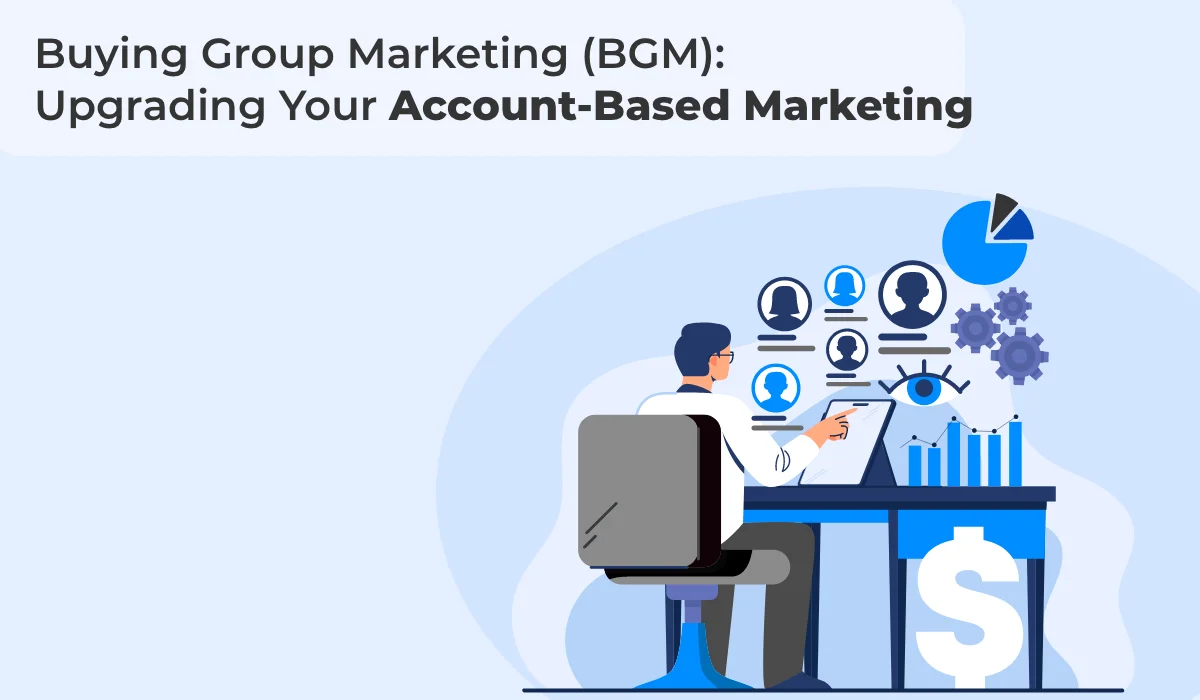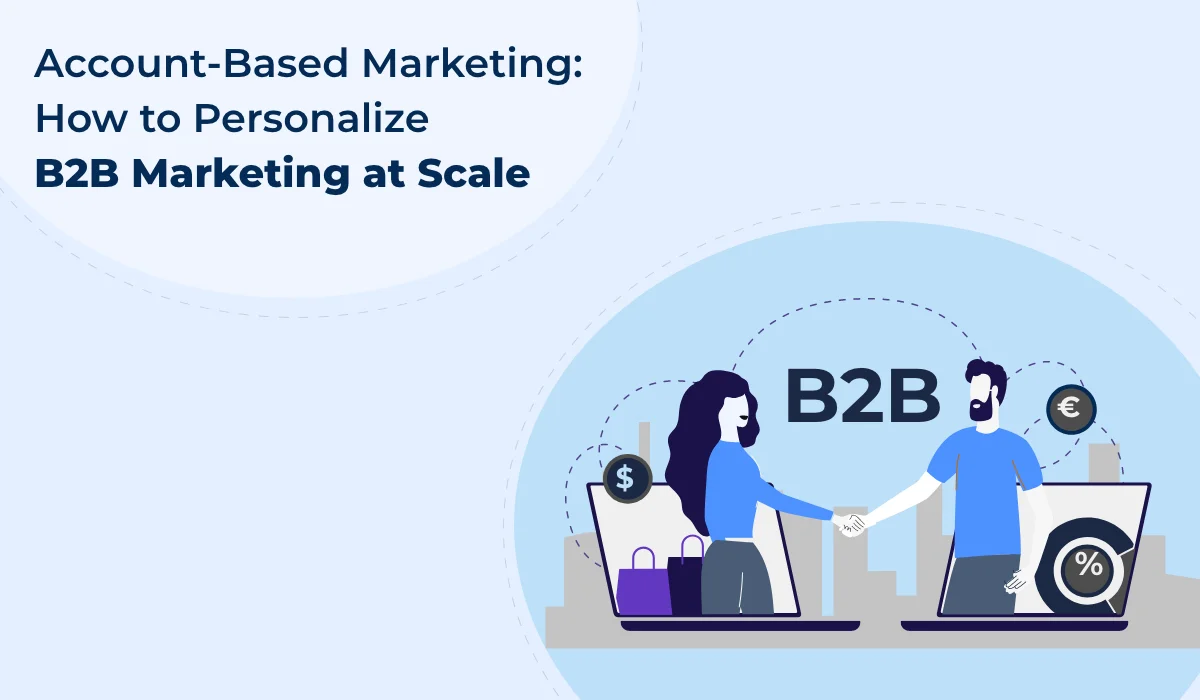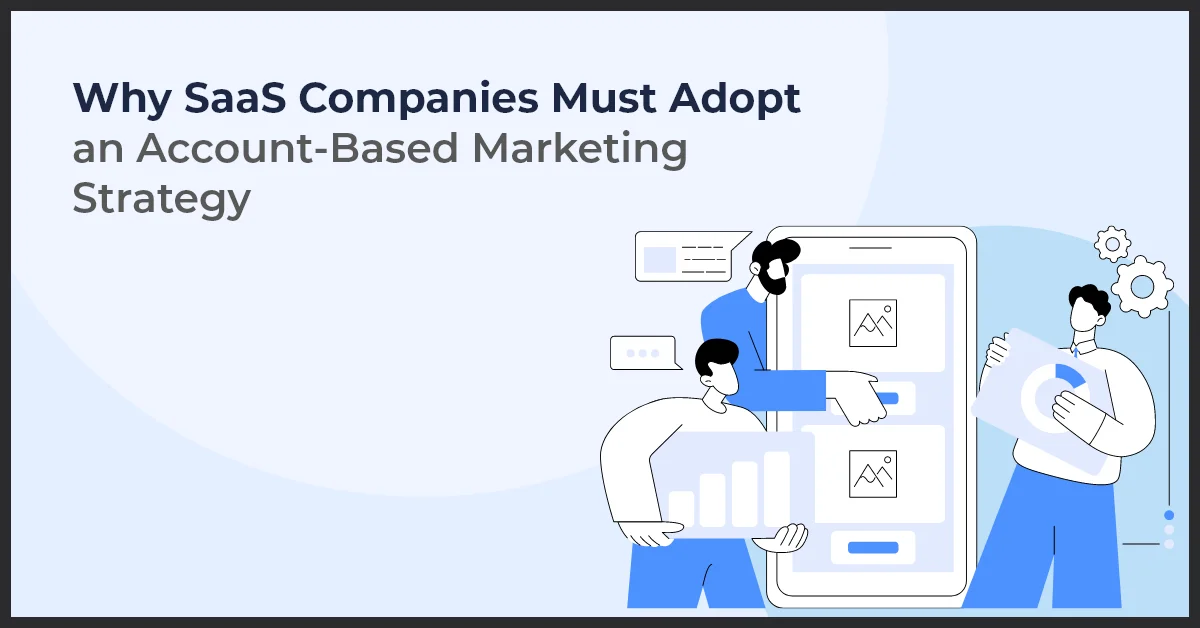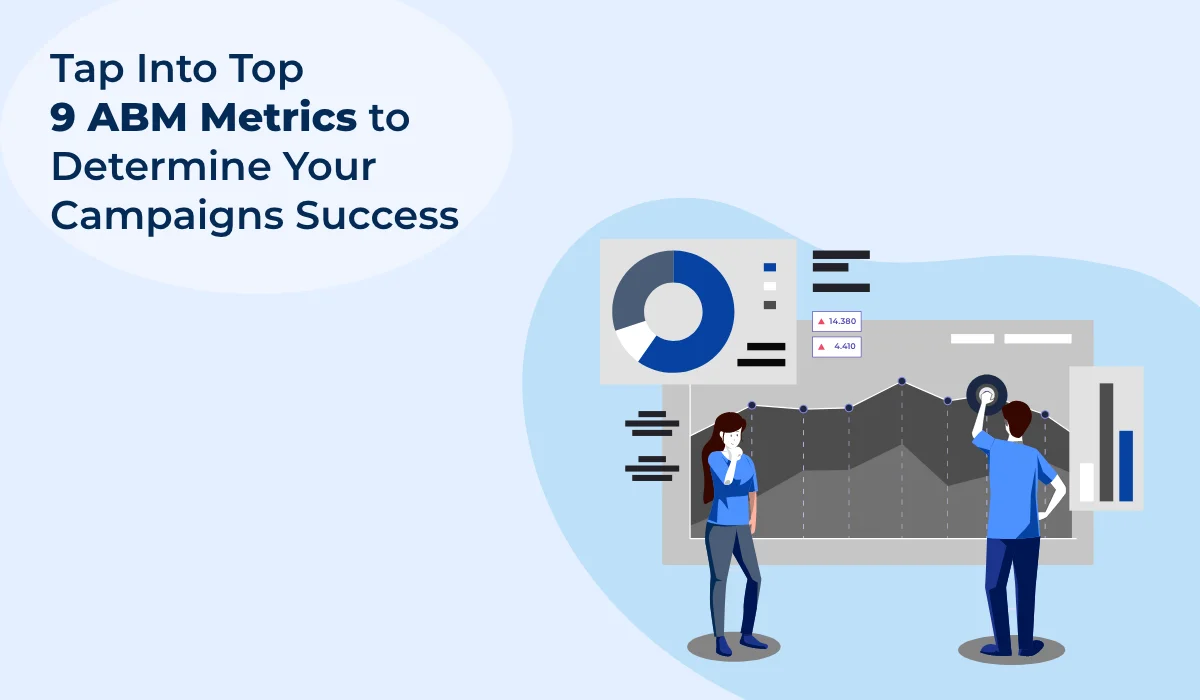Buying Group Marketing (BGM) for Effective Account-Based Marketing

Published on: January 4, 2023
Updated on: February 06, 2025
4470 Views
- Account Based Marketing
10 min read
Until recently, B2B marketing was assumed to be a one-on-one interaction between two businesses. Account-based marketing (ABM) reinforced this as marketers engaged with each customer account through more relevant, personalized messaging and content. Today, ABM has gone a step further and evolved into buying group marketing (BGM).
BGM has added another dimension to ABM as marketing tactics now focus on decision-makers within accounts. This way, their personalized message is targeted to a specific ‘buying group’ within a company.
Let’s find out more about how it takes place.
What Is Buying Group Marketing (BGM)?
Buying group marketing (BGM) is a modern marketing framework that takes a practical and tactical approach to interact with potential buyers. It aligns sales and marketing teams and impacts the bottom line by creating a better experience for prospects throughout the buying journey.
BGM Advantages
- One of the main advantages of BGM is that it allows you to focus on specific targets within an account based on different parameters. This granular approach lets you consider the needs of individual members of the buying group and the best ways to engage them and validate their decisions.
- Another benefit of BGM is that it protects revenue by ensuring a broader web of connections across an account and measures engagement with key decision-makers. This can help increase retention rates and reduce the risk of losing business if a single advocate leaves the account.
To effectively implement BGM, an organization needs to understand the business requirements of its target accounts and create a comprehensive marketing strategy to address them. This includes creating high-quality, relevant content that aligns with the current stage of the buying group in the purchasing journey.
Overall, BGM is a powerful tool for creating a personalized and effective marketing strategy that drives revenue growth and customer satisfaction.
Stepping Up from Account-Based Marketing
Account-based marketing (ABM) and Buying group marketing (BGM) differ in the numbers for the latter’s targeted audience. Consider the scenario.
You want to close a deal with one of your clients, Microsoft. Microsoft, say, has a total of 190,000 employees worldwide. Your target customers are its employees in the US, so the number of people comes down to 107,000.
If only 33% of Microsoft's US workforce is in the product R&D department, which is the potential audience of your product, that further reduces the target count to just over 35,000 people. That’s the target audience for ABM--you would begin your marketing efforts by targeting this broad group of 35,000 individuals.
However, in the case of BGM, you focus on specific buying team members at Microsoft, potentially only a small number of people involved in the decision-making process. This targeted approach allows you to create a more personalized and effective marketing strategy focused on the needs of the specific individuals you need to engage in closing the sale.
B2B as a Buying Group
The Forrester Buying Groups Manifesto begins with the statement: “The B2B buyer is a buying group.” This is the evolved thought in today’s business environment.
B2B organizations must know the needs of their buying groups rather than just individual buyers. So how did this change of thought take place?
Buying groups in B2B purchases often consist of multiple individuals from different departments within the same organization. Marketing teams that focus solely on the initial lead may ignore signals from additional members of the buying group who are involved in the process later on. This can lead to missed opportunities and decreased sales performance.
Organizations can improve their marketing and sales efforts by shifting from a leads-centric approach to focusing on the entire buying group. This may require significant internal processes and systems changes, but even small steps in this direction can be significantly impactful.
Data from Gartner suggests that the average buying team in B2B consists of between 14 and 23 people. Further, 66% of B2B purchases involve more than six people. This means it is essential to build marketing strategies that consider the needs of groups of stakeholders rather than just individuals.
Buying Group Marketing (BGM) Fundamentals
The following section explains the fundamentals to help fine-tune your BGM strategy.
Zoom on Strategy
In today's marketing landscape, businesses must find ways to stand out among the numerous ads that customers encounter daily. While ABM is important for strategizing, companies also need to find ways to reach and connect with their audiences more effectively.
To effectively implement BGM, organizations must first identify and understand their target audience, build a strong and well-resourced team, and develop a basic strategy. While there may be various opinions and approaches to ABM, BGM is more concrete from the start, with aligned metrics, a forward-looking pipeline plan, and shared data among team members that contribute to a successful strategy.
Let’s look at some of these strategies in detail.
BGM Strategies
Identifying target groups: The first step in implementing a BGM strategy is to identify the groups that you want to target. This may involve researching different industries, geographies, or other characteristics to find groups of businesses interested in your products or services.
Building relationships: Once you have identified your target groups, the next step is to build relationships with the businesses within those groups. This may involve reaching out to group leaders or members to introduce your products or services, attending industry events, and networking with potential customers.
Negotiating favorable terms: After building relationships with the businesses within your target groups, negotiate favorable terms for your products or services. This could involve offering discounts, extended payment terms, or other incentives to encourage group members to purchase from you.
Providing value: Besides offering discounts or other incentives, it's important to give value to group members. This may involve offering training and support, providing access to research and market data, or offering other benefits relevant to the group's needs.
Building loyalty: Finally, building loyalty among group members is essential . This may involve providing excellent customer service, offering ongoing support and assistance, and regularly communicating with group members to understand their needs and preferences.
After establishing a BGM strategy and understanding the specific individuals within the target buying group, the next step is to focus on reach and engagement.
Make the Customer Journey Come to Life
Internal divisions, insufficient data, and poor communication can result in a disconnected customer experience. However, BGM can help improve the customer journey. While traditional marketing often targets an entire account, BGM encourages businesses to focus on specific individuals or groups within an account that would benefit from more targeted marketing and sales efforts. This approach requires you to consider the needs of these targets and the most effective ways to engage with them and validate their decisions.
Once you’ve identified these target individuals or groups, your next step is to deliver and coordinate the customer experience. The journey depends on the role of each group member, such as influencer, key decision-maker, or user. However, BGM allows you to engage with multiple buying groups within larger accounts and ensure that each target receives relevant content that aligns with their current stage in the purchasing journey.
A crucial aspect of the customer experience is also creating compelling content. If the content presented to buyers is uninteresting, poorly timed, or irrelevant to their purchasing journey, customers will not engage with it. In short, a waste of your resources.
BGM helps businesses understand what is important by measuring engagement that provides valuable insights into the intent to purchase. By using this approach, marketers can tailor their content and strategies to their target audience’s specific needs and interests rather than using a "spray and pray" approach.
BGM also helps protect revenue by increasing retention rates. When a business only has a relationship with a single individual within an account, and that person leaves their position, it is unlikely that the account will renew, resulting in lost revenue. BGM allows you to build relationships with multiple individuals within an account and track engagement with key decision-makers, which can increase the likelihood of retention and help protect revenue.
Smarketing: Unifying Sales and Marketing
Many companies try to bring their marketing and sales teams together and align their efforts, but this can be challenging. Traditional processes have often resulted in separate operations between sales and marketing teams, and it can be hard to achieve alignment without shared goals, metrics, and collaboration. BGM helps teams consider an account as a whole rather than viewing internal processes as exclusively sales or marketing tasks.
BGM helps eliminate internal divisions and creates a unified strategy and sales funnel where marketing and sales teams share metrics and work together to close deals. A prospect's experience should not be disrupted by an internal transfer or a flawed internal structure, as poor customer experiences do not lead to sales. With BGM, marketing can go beyond the top of the funnel and collaborate with sales teams and prospects to improve the buying experience.
Implementing BGM on Sales Funnel
Top of the Funnel
To effectively target a buying group at the start of the sales process, you should focus on creating awareness and understanding the needs of your target account. Using social media ads and landing pages that serve as incentives to attract potential customers can help you achieve this goal.
Middle of the Funnel
To effectively engage and educate buying groups in the middle of the sales process, post relevant content on social media platforms and foster interaction with group members. LinkedIn messages from sales development representatives and support from ads and landing pages can be an effective approach.
Bottom of the Funnel
Conversations that lead to conversions typically begin when the buying group is near the end of the sales process. At this stage, account executives can present group members with persuasive content that addresses their pain points and helps influence them to purchase.
To effectively implement BGM, B2B marketers should start by understanding the business needs of the target account and developing a comprehensive marketing strategy to address these needs. The next step is coordinating a comprehensive buying committee experience through high-quality, relevant content.
Achieving alignment between marketing and sales on a strategic, operational, and practical level will help increase the chances of success and higher conversions.
Conclusion
BGM is a strategic approach to better understand and engage with the specific members of a buying group to improve the customer experience and drive conversions. By focusing on the needs and pain points of the individuals within a buying group and delivering personalized, relevant content, you can build trust and credibility with your target audience.
BGM also helps to break down internal silos between marketing and sales teams and creates a more seamless, integrated approach to closing deals. You can more effectively engage and convert your target accounts by aligning goals and metrics and collaborating to deliver a holistic customer experience.
Want to see what BGM looks like for your business? Growth Natives can help you out. Get in touch with us at info@growthnatives.com and see how easy it is to get started.
Frequently Asked Questions
Traditional ABM typically targets specific high-value accounts and key decision-makers within those accounts. BGM, on the other hand, targets not just individual decision-makers but the entire buying group, understanding that multiple stakeholders often influence purchasing decisions. BGM provides tailored content and messaging to address the needs and concerns of each group member.
BGM improves alignment by fostering collaboration and communication between marketing and sales teams. Both teams work together to identify and understand the buying group, develop targeted content, and coordinate outreach efforts. This shared focus ensures a cohesive approach to engaging and converting accounts.
Data is crucial in BGM for identifying buying groups, understanding stakeholder behavior, and personalizing content. Marketers use data to map out the buying group, track engagement, measure campaign performance, and make data-driven adjustments to their strategies. Accurate data helps ensure that marketing efforts are targeted and effective.
Technology supports BGM initiatives through tools such as customer relationship management (CRM) systems, marketing automation platforms, and data analytics software. These tools help marketers identify buying groups, automate personalized outreach, track interactions, and analyze results to optimize campaigns
Companies can measure the success of their BGM efforts by tracking key performance indicators (KPIs) such as engagement rates, lead conversion rates, sales cycle length, deal size, and customer satisfaction. Additionally, analyzing feedback from sales teams and buying group members can provide insights into the effectiveness of BGM initiatives.



